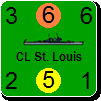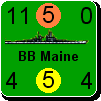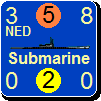Red Prince
Posts: 3686
Joined: 4/8/2011
From: Bangor, Maine, USA
Status: offline

|
quote:
ORIGINAL: Centuur
quote:
ORIGINAL: brian brian
[I got detoured writing the post about counter-attack by going out to help fix a brake line to help a friend get home from work and I forgot to make one of my AI calculation points more explicit. I only wanted to comment once the water had flowed under the bridge, or backed up against the damns of the Dnepr in this case, should the Germans want to try such a stunt again. I hope that as the # of HQs goes down, their AI 'value' goes up. If the Axis are invading European Russia with 8 or even more HQs (not unheard of), looking at that attack would be completely different. Also, 1941 is a far more critical situation for the Russians than 1942 tends to be, so the value of something successful like taking out 25% of the Axis logistic capacity (and 50% of it's most mobile logistics) for either a small risk or no risk (with Chit or other ARM in area) should be worth more. By the time the Russians can afford more attack ideas, probably they can build a new chit. In dangerous 1941, it can be an important asset to their defense, and should not just be hoarded for better times later in the war. (I tend to use it to flip up all HQs after they re-organize the Reserves, not as much of a concern in a M/A 41 attack). With no Luftwaffe left on the southern front right then, and not much that can shift there either, the risk of coming out in front of the Dnepr momentarily was a bit lower then too, especially once the Germans went down to just two face-up HQs for the balance of the turn, leaving the Axis with only two axes of attack.
I fully agree that the Russians should never counterattack when failure is too risky at this point in the war, and you shouldn't attack an enemy HQ just because you can right now (later, heck yes; the Russians can attack Zhukov style as much as possible at even low odds against single Axis HQ or ARM). But you always have to be looking at the possibilities. Even now in China, if a disorganized oos unit appeared adjacent to the last few Chinese units that could be taken out at 7-1 +1 for a dramatic improvement in their final position, you have to consider something like that. If you never take any risks at all on the defense, your position will suffer. I just thought that example was a good place to consider how to set that risk/reward equation. And how to set the reward value of your enemy losing so much future capability all at once.
And as usual this whole website illuminates the tiny details that create a "Played It Wrong" and indeed my usual opponent and I have missed that one about the GBAs for years running now, thanks C99. Russia can start thinking about them soon here.....Russia gets bigger as you go in deeper....and odd corners of the Axis line lose their supply links when the weather goes bad.....promoted GBA units can make the Caucasus impossible to crack....Red Prince's Russians are doing very well.....carry on.]
I agree on this. Even when on defense, there might be a possibility for a counter attack which could break the German advance. When the attack on the HQ-A was proposed, I was a little in doubt whether it should or should not be done, therefore I didn't react on this. Looking back, however: I probably would have done so, even with vBock also in that theater. It is a risk, that's for sure, but the rewards were very, very high.
But Red Prince is doing all right at the moment with the defenses. After next Axis impulse, we have to assess the situation very carefully, since there are at that moment two options for the USSR: run away or stand and fight. That's probably going to be a difficult decision.
About a combined impulse coming up for the Germans. I hate combined impulses, because it's to restricted on allowable action and land moves. I would have preferred an air impulse to get all air units in a better position. What are those few land moves and the naval move going to do at the Russian front? Nothing.
A combined impulse is only necessary for invasions you want to do, without giving the other side a clue where it is coming. That (and the super combined) are the only combined impulses I take, except when I want to sail the German SUB fleet into action and not want any other naval moves. That's it.
The decision to take a Combined was made based on 2 factors: it allows me to bring the most usefull aircraft ot the front (I got 2 of the 10 there last impulse), and I do want to take that SUB action, but don't need any other Naval Moves.
The strategic bombing campaign has been somewhat crippling so far this turn, but it's early enough in the turn that Germany and Italy can still try to do the same thing to the CW. They have to do it through Sub warfare, though. Given the early entry to the war, the USA and CW both still lack the huge fleets they'll have next year and the year after, so they are going to run out of things to do each impulse soon. They also have few land units, at least the USA does. The CW can take Land Actions to move up the East African Coast, but the USA will be pretty much finished in 2 more impulses.
If this turn lasts as long as it did last year (unlikely), we haven't even reached the mid-point yet. It's impulse #6, and the Dnieper can't easily be broken yet. Because the Germans are limitted on units on both fronts, I'm trying to clean up the reinforcement cities that could give me trouble later if I try to sceen them -- Odessa, Pskov, Novgorod. Unless I can completely surround them, these cities can end up adding a unit each turn until my screening force is too vulnerable. In fact, I fully intend to completely block Leningrad, including flipping a unit to get it into the swamp, just so I don't have to worry about it again for a while.
_____________________________
Always listen to experts. They'll tell you what can't be done and why. Then do it!
-Lazarus Long, RAH
|
 Printable Version
Printable Version

























 When you get a chance, the bomber (range 7) should rebase to Baku.
When you get a chance, the bomber (range 7) should rebase to Baku.

 New Messages
New Messages No New Messages
No New Messages Hot Topic w/ New Messages
Hot Topic w/ New Messages Hot Topic w/o New Messages
Hot Topic w/o New Messages Locked w/ New Messages
Locked w/ New Messages Locked w/o New Messages
Locked w/o New Messages Post New Thread
Post New Thread